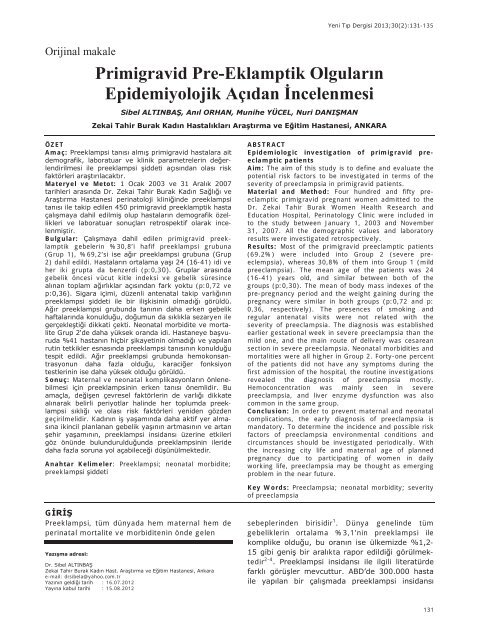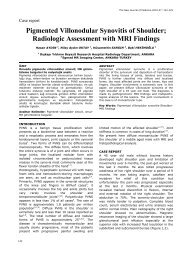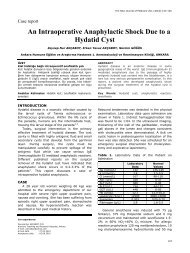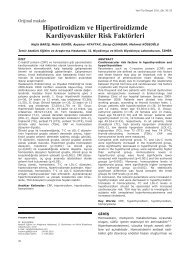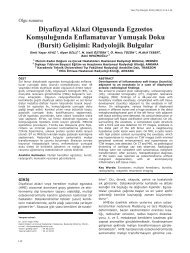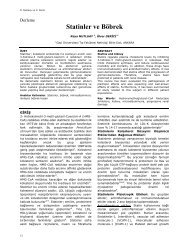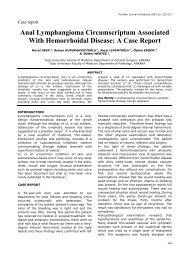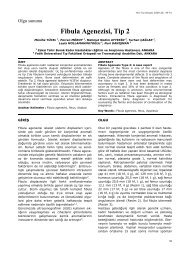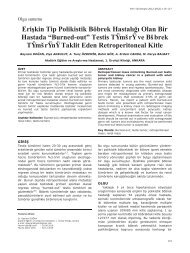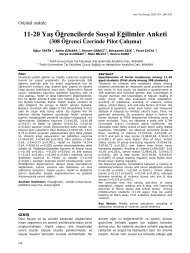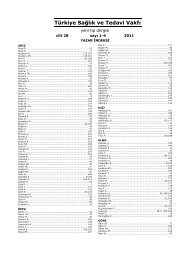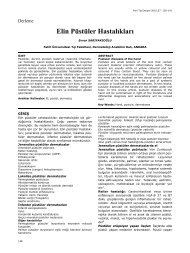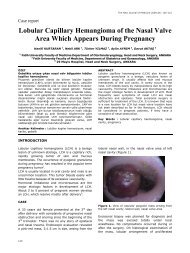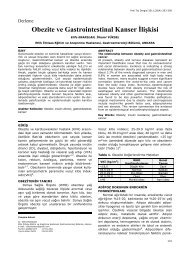Primigravid Pre-Eklamptik Olguların ... - Yeni Tıp Dergisi
Primigravid Pre-Eklamptik Olguların ... - Yeni Tıp Dergisi
Primigravid Pre-Eklamptik Olguların ... - Yeni Tıp Dergisi
Create successful ePaper yourself
Turn your PDF publications into a flip-book with our unique Google optimized e-Paper software.
-135<br />
Orijinal makale<br />
<strong>Primigravid</strong> <strong>Pre</strong>-<br />
<br />
<br />
<br />
ÖZET<br />
Amaç: <br />
-<br />
<br />
<br />
Materyel ve Metot: <br />
<br />
<br />
<br />
-<br />
-<br />
tir.<br />
Bulgular: dilen primigravid preeklamptik<br />
gebelerin %30,8’i hafif preeklampsi grubuna<br />
(Grup 1), %69,2’si <br />
2) dahil edildi. H-41) idi ve<br />
her iki grupta da benzerdi (p:0,3 <br />
gebelik öncesi vücut kitle indeksi ve gebelik süresince<br />
(p:0,72 ve<br />
<br />
<br />
<br />
ryen ile<br />
-<br />
-<br />
<br />
<br />
-<br />
<br />
<br />
Sonuç: Maternal ve neonatal komplik-<br />
<br />
<br />
-<br />
<br />
geçirilmelidir. K-<br />
<br />
<br />
<br />
.<br />
Anahtar Kelimeler: <strong>Pre</strong>eklampsi; neonatal morbidite;<br />
preekla<br />
ABSTRACT<br />
Epidemiologic investigation of primigravid preeclamptic<br />
patients<br />
Aim: The aim of this study is to define and evaluate the<br />
potential risk factors to be investigated in terms of the<br />
severity of preeclampsia in primigravid patients.<br />
Material and Method: Four hundred and fifty preeclamptic<br />
primigravid pregnant women admitted to the<br />
Dr. Zekai Tahir Burak Women Health Research and<br />
Education Hospital, Perinatology Clinic were included in<br />
to the study between January 1, 2003 and November<br />
31, 2007. All the demographic values and laboratory<br />
results were investigated retrospectively.<br />
Results: Most of the primigravid preeclamptic patients<br />
(69.2%) were included into Group 2 (severe preeclempsia),<br />
whereas 30,8% of them into Group 1 (mild<br />
preeclampsia). The mean age of the patients was 24<br />
(16-41) years old, and similar between both of the<br />
groups (p:0,30). The mean of body mass indexes of the<br />
pre-pregnancy period and the weight gaining during the<br />
pregnancy were similar in both groups (p:0,72 and p:<br />
0,36, respectively). The presences of smoking and<br />
regular antenatal visits were not related with the<br />
severity of preeclampsia. The diagnosis was established<br />
earlier gestational week in severe preeclampsia than the<br />
mild one, and the main route of delivery was cesarean<br />
section in severe preeclampsia. Neonatal morbidities and<br />
mortalities were all higher in Group 2. Forty-one percent<br />
of the patients did not have any symptoms during the<br />
first admission of the hospital, the routine investigations<br />
revealed the diagnosis of preeclampsia mostly.<br />
Hemoconcentration was mainly seen in severe<br />
preeclampsia, and liver enzyme dysfunction was also<br />
common in the same group.<br />
Conclusion: In order to prevent maternal and neonatal<br />
complications, the early diagnosis of preeclampsia is<br />
mandatory. To determine the incidence and possible risk<br />
factors of preeclampsia environmental conditions and<br />
circumstances should be investigated periodically. With<br />
the increasing city life and maternal age of planned<br />
pregnancy due to participating of women in daily<br />
working life, preeclampsia may be thought as emerging<br />
problem in the near future.<br />
Key Words: <strong>Pre</strong>eclampsia; neonatal morbidity; severity<br />
of preeclampsia<br />
G<br />
<strong>Pre</strong>eklampsi, tüm dünyada hem maternal hem de<br />
perinatal mortalite ve morbiditenin önde gelen<br />
<br />
<br />
<br />
e-mail: drsibela@yahoo.com.tr<br />
: 16.07.2012<br />
: 15.08.2012<br />
sebeplerinden birisidir 1 . Dünya genelinde tüm<br />
gebeliklerin ortalama %3,1’nin preeklampsi ile<br />
-<br />
kt tedir<br />
2-4 <br />
<br />
<br />
131
-<br />
lirken, Lawler ve ark.’<br />
77, <br />
<br />
5,6 <br />
-<br />
7 .<br />
Türkiye’de Büyükören ve ark.’<br />
<br />
8 .<br />
<strong>Pre</strong>eklampsi için risk faktörl -<br />
1,2,6 <br />
ailede hipertansiyon,<br />
k lupus gibi otoim-<br />
-<br />
<br />
<br />
hidrops fetalis, kötü kontrollü diyabet, mol hidatiform,<br />
pozitif kardiolipin testi, genetik faktörler,<br />
<br />
<br />
<br />
<br />
-<br />
<br />
olmazsa paritenin koruyucu etkisi ortadan kalkar 9 .<br />
<br />
<br />
preeklampsi g 2,10 .<br />
-<br />
<br />
isten<strong>Pre</strong>eklampsi<br />
öyküsü, sadece bir sonraki gebelikte preeklampsi<br />
a ileride ortaya<br />
<br />
11 .<br />
bunda<br />
gösterilen primigravid preeklamptik gebe-<br />
<br />
<br />
MATERYAL VE METOT<br />
1 Ocak 2003 - <br />
<br />
K’nde yatarak<br />
ted313 idi.<br />
-<br />
<br />
primigravid hasta dahil edildi. Kronik hipertansi-<br />
-<br />
<br />
l edilen 445 hasta, klinik ve labora-<br />
<br />
olarak iki alt grupta incelendi. Gruplardan elde<br />
edilen veriler birbirleri ve literatür ile benzerlikler<br />
ç<br />
<br />
<br />
<br />
protei 300 mg<br />
<br />
tüm bilgiler, protokol defterleri ve ar<br />
<br />
-küretaj öyküsü,<br />
ultrasonografi (USG) ve son adet tarihine (SAT)<br />
<br />
-sigara kul k<br />
<br />
<br />
<br />
<br />
bejen, glukoz, kara-<br />
siyon testleri (AST, ALT), laktat dehidrogenaz<br />
(LDH), total protein, albumin, böbrek fonksiyon<br />
testleri (üre, kreatinin), bilirubin, <br />
ekli,<br />
<br />
APGAR skoru (1. ve 5. dakikadaki) not edildi.<br />
<br />
<br />
(Sistolik TA + (Diastolik TA<br />
x2)/ <br />
afif hipertansiyon,<br />
<br />
hipertansiyon olarak kabul edildi.<br />
A <br />
<br />
<br />
üri (5 gr/24 saat)<br />
üri (500 ml/24 saat)<br />
üel bulgular<br />
<br />
<br />
n en az<br />
<br />
3 )<br />
<br />
<br />
based stati <br />
<br />
-Kare<br />
-<br />
Whi <br />
<br />
nicel veriler için aritmetik ortalama +/- standart<br />
<br />
BULGULAR<br />
eek-<br />
8) hafif preeklampsi<br />
(Grup 1), 308’i (% 69,<br />
-<br />
-41) olarak tespit edildi.<br />
132
’i <br />
%kati<br />
-<br />
<br />
%6,3’ünün (n: <br />
2 unun (n:82)<br />
26-35 kg/m 2 ve sadece %4,9’unun (n:23) >35 kg/m 2<br />
o0,72) (Tablo 1). Gebelik es-<br />
a her iki grupta benzer idi<br />
(p:0,36).<br />
<br />
<br />
-<br />
<br />
01)<br />
- <br />
<br />
-<br />
sahip olan gebelerin %40,3’ü (n: 242) hafif<br />
preeklampsi grubunda idi (p
Tablo 2. <strong>Pre</strong>eklampsi iddetine Göre HLaboratuar <br />
Hafif <strong>Pre</strong>eklampsi <br />
(N: 137)<br />
(N: 308)<br />
Hemoglobin (gr/dl) , ort. +/- SD 11,8 +/-1,9 12,7+/-1,7
n<br />
3-5 . Özdemir ve ark., bizim<br />
-<br />
iken<br />
16 .<br />
<strong>Pre</strong>matü<br />
<br />
<br />
<br />
<br />
-<br />
ta<br />
9,10 .<br />
-<br />
<br />
<br />
<br />
-<br />
bu<br />
-<br />
mektedir<br />
41’inde<br />
<br />
<br />
al takibin önemini göstermektedir.<br />
Waugh ve ark.<br />
<br />
17 <br />
<br />
<br />
<br />
(%87,4) <br />
<br />
<br />
<br />
<br />
<br />
-<br />
-<br />
-<br />
-<br />
18 <br />
<br />
e<br />
ürde de trombo-<br />
ek-<br />
<br />
18 .<br />
<br />
<br />
eratürde orta serebral ve<br />
uterin laroluyla preek-<br />
<br />
19 .<br />
Sonuç olarak -<br />
-<br />
<br />
hem anne hem de bebek<br />
<br />
-<br />
-<br />
-<br />
20 . Bu sayede, literatürde yer alan<br />
-<br />
21,22 .<br />
REFERANSLAR<br />
1. Mustafa R, Ahmed S, Gupta A, Venuto RC. A comprehensive<br />
review of hypertension in pregnancy. J <strong>Pre</strong>gnancy 2012;2012:105918. Epub<br />
2012 May 23.<br />
2. Melamed N, Hadar E, Peled Y, Hod M, Wiznitzer A, Yogev Y. Risk<br />
for recurrence of preeclampsia and outcome of subsequent pregnancy in<br />
women with preeclampsia in their first pregnancy. J Matern Fetal Neonatal<br />
Med 2012 May 16. [Epub ahead of print].<br />
3. Erden AC, Yayla M. <strong>Pre</strong>eklampsi ve eklampside maternal fetal<br />
morbidite mortalite. Perinatoloji 1993;1:24-30.<br />
4. Akar ME, Eyi EG, Yilmaz ES, Yuksel B, Yilmaz Z. Maternal deaths<br />
and their causes in Ankara, Turkey, 1982-2001. J Health Popul Nutr 2004;<br />
22(4):420-8.<br />
5. Zhang J, Meikle S, Trumble A. Severe maternal morbidity<br />
associated hypertensive disorders in pregnancy in United states. Hypertens<br />
<strong>Pre</strong>gnancy 2003;22:203-12.<br />
6. Lowler J, Osman M. Population-based analysis of hypertensive<br />
disorders in pregnancy. Hypertension in pregnancy 2007;26:67-76.<br />
7. Ventura SJ, Martin JA, Cutin SC, Abma JC, Henshaw W. Births:<br />
Final data for 1999. National Vital Satistics Reports 2001;49:1-100.<br />
8. Buyukoren A, Turfanda A. Gebelik toksikozu görü <br />
tesi <strong>Dergisi</strong> 1992;23:581-5.<br />
9. Skjaerven RS, Wilcox AJ, Lie RT. The interval between pregnancies<br />
and the risk of preeclampsia. N Engl J Med 2002;346:33-38.<br />
10. Odegård RA, Vatten LJ, Nilsen ST, Salvesen KA, Austgulen R.<br />
<strong>Pre</strong>eclampsia and fetal growth. Obstet Gynecol 2000;96(6):950-5.<br />
11. Aukes A, De Groot J, Wiegman M, Aarnoudse J, Sanwikarja G,<br />
Zeeman G. Long-term cerebral imaging after pre-eclampsia. BJOG 2012;<br />
119(9):1117-22.<br />
12. <br />
<br />
Retrospektif Analizi. T Klin Obstet 2002;12:38-42.<br />
13. Augistin Conde-Agudelo, Jose MB. Risk factors for preeclempsia in<br />
a large cohort of Latin American and Caribbean Women. British Journal<br />
Obstet & Gynecology 2000;107:75-82.<br />
14. Martin LC, Hall MH, Campbell DM. The effect of smoking on<br />
preeclamsia in twin pregnancy. British Journal of Obstetrics and Gynecology<br />
2000;107:745-49.<br />
15. Salihu HM, De La Cruz C, Rahman S, August EM. Does maternal<br />
obesity cause preeclampsia A systematic review of the evidence. Minerva<br />
Ginecol 2012;64(4):259-80.<br />
16. <br />
sendromunda maternal morbidite ve mor <br />
Fakültesi <strong>Dergisi</strong> 2003;3:5-9.<br />
17. Waugh J, Perry IJ, Halligan AW, De Swiet M, Lambert PC, Penny<br />
JA, et al. Birth weight and 24-hour ambulatory blood pressure in<br />
nonproteinuric hypertensive pregnancy. Am J Obstet Gynecol 2000;183(3):<br />
633-7.<br />
18. Calvert SM, Tuffnell DJ, Haley J. Poor predictive value of platelet<br />
count, mean platelet volume and serum urate in hypertension in pregnancy.<br />
Eur J Obstet Gynecol Reprod Biol 1996;64:2:179-184.<br />
19. Jodicke C, Maulik D, Singh P, Heitmann E, Maulik D. Role of<br />
ultrasound in pre-eclampsia. Minerva Ginecol 2012;64(4):293-308.<br />
20. Forest JC, Charland M, Massé J, Bujold E, Rousseau F, Lafond J, et<br />
al. Candidate biochemical markers for screening of pre-eclampsia in early<br />
pregnancy. Clin Chem Lab Med 2012;1;50(6):973-84.<br />
21. Roberge S, Giguère Y, Villa P, Nicolaides K, Vainio M, Forest JC, et<br />
al. Early Administration of Low-Dose Aspirin for the <strong>Pre</strong>vention of Severe<br />
and Mild <strong>Pre</strong>eclampsia: A Systematic Review and Meta-Analysis. Am J<br />
Perinatol 2012 Apr 11. [Epub ahead of print]<br />
22. Kasawara KT, Nascimento SL, Costa ML, Surita FG, E Silva JL.<br />
Exercise and physical activity in the prevention of preeclampsia: systematic<br />
review. Acta Obstet Gynecol Scand 2012;22(2):189-94.<br />
135


